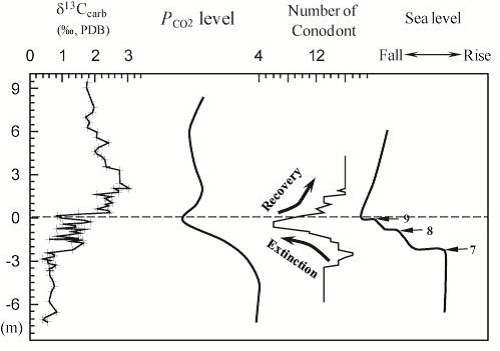Carbon isotopic evidence for the associations of decreasing atmospheric CO2 level with the Frasnian-Famennian mass extinctionUpdate time:06 07, 2012
Vice Professor XU Bing and his team carry out high-resolution analyses of coupled inorganic and organic carbon isotope on two late Devonian carbonate sequences in south China. The primary aims of this study are to characterize the changes of atmospheric CO2 level during the F-F transition and address the links between the perturbation of the global carbon cycle and the mass extinction. The timing of carbon isotope excursions, eustatic change, and conodont evolution across the F-F boundary provides key evidence for identifying the association of carbon cycle with the mass extinction. The onset of conodonts extinction coincides with the sea level fall, while it postdates that of atmospheric CO2 level decrease. Furthermore, the severest extinction occurs during the interval with the lowest pCO2 level and sea level. These observations suggest that the environmental changes induced by lowering pCO2 level, such as temperature decrease and marine regression, might be the important factors for the F-F mass extinction.
Fig.1 Relationships among δ13Ccarb, pCO2 level, conodont evolution, and sea level changes across the F-F boundary in the Dongcun section. (Image by XU) Xu et al. Carbon isotopic evidence for the associations of decreasing atmospheric CO2 level with the Frasnian-Famennian mass extinction. Journal of Geophysical Research, 117, G01032, doi:10.1029/2011JG001847 (Download Here)
|
Contact
Related Articles
Reference
|
-
SIMSSecondary Ion Mass Spectrometer Laboratory
-
MC-ICPMSMultiple-collector ICPMS Laboratory
-
EM & TEMElectron Microprobe and Transmission Electron Microscope Laboratory
-
SISolid Isotope Laboratory
-
StIStable Isotope Laboratory
-
RMPARock-Mineral Preparation and Analysis
-
AAH40Ar/39Ar & (U-Th)/He Laboratory
-
EMLElectron Microscopy Laboratory
-
USCLUranium Series Chronology Laboratory
-
SASeismic Array Laboratory
-
SEELaboratory of Space Environment Exploration Laboratory
-
PGPaleomagnetism and Geochronology Laboratory
-
BioMNSFrance-China Bio-mineralization and Nano-structure Laboratory

 Print
Print Close
Close
